When marketing agencies use the right software stack, scattered projects and messy workflows become smooth, organized systems.
But with so many options available, knowing which tools are worth your time and budget can be hard.
In this article, you’ll discover seven must-have software solutions supporting different marketing agency needs and how to pick the best fit for your business.
Key takeaways from marketing agency software
The right marketing agency software stack combines CRM, project management, reporting, social media, email, content and accounting tools.
Start with tools that solve your biggest pain points – like client relationship management and project coordination – before adding specialized platforms.
Look for software designed specifically for agencies, like white-label reporting and multi-client management features, rather than generic business tools.
Pipedrive works as your agency’s CRM, project management platform and email marketing tool in one solution – try it free for 14 days.
What are key features to look for in marketing agency software?
The right marketing agency software combines must-have functionality and user-friendliness to boost productivity.
While every agency has unique needs, here are the core features to consider when evaluating your options:
Feature | Why it matters |
Customer relationship management (CRM) |
|
Project management |
|
Reporting and analytics |
|
Time tracking and billing features |
|
Collaboration tools |
|
Integration ecosystem |
|
|
|
|
Ultimately, knowing which features to prioritize and what you can add later as you scale is essential to investing in the right technology for your company’s needs.
How to choose marketing agency software for your SMB?
Follow these six simple steps to select software that aligns with your marketing business and growth plans:
Audit your current workflows. List your pain points – think scattered client communications, manual reporting and project bottlenecks. Prioritize functionality that will have the fastest impact.
Consider your team size. Small agencies benefit from all-in-one platforms combining CRM, project management and basic reporting. Larger agencies (20+ people) may need additional functionality through tools that integrate well together.
Plan your total budget. In addition to software subscription and integration fees, account for any hidden costs, such as tool onboarding time and staff training expenses.
Evaluate integration capabilities. Consider software that best fits your workflow and connects seamlessly with your existing tech stack to reduce manual effort and eliminate project, data and team silos.
Try before you buy. Leverage free trials from reputable platforms before you commit to test-drive features on real workflows with your team.
Focus on user adoption. Involve your team in tool evaluation and selection. Prioritize software that they find intuitive and valuable for their work.
Now that you have a clear picture of your marketing agency’s requirements, it’s time to navigate the best options on the market.
Top 7 marketing agency software solutions
The right marketing tool will transform your agency operations.
Here are seven platforms that address different aspects of marketing agency workflows, including an all-in-one solution and specialized software to address specific functions.
1. Best for CRM and end-to-end client communication: Pipedrive
Pipedrive is a customer relationship management (CRM) tool that helps marketing agencies communicate with their clients while tracking leads and deals in one place.
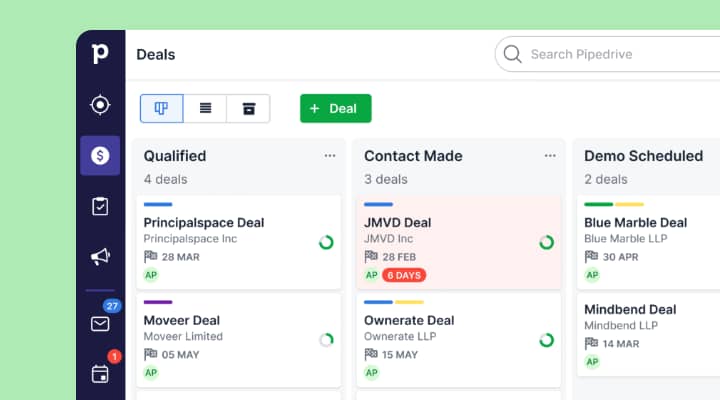
Potential clients often need several meetings and team approval before signing a marketing contract. The relationship changes completely once they become paying clients.
With Pipedrive, you can monitor exactly where each prospect is in your sales process. And communicate with them effectively at each stage of the marketing funnel.
Once you’re working together, all client marketing information (outreach, project history, email chains, renewal info, etc.) stays on the platform so nothing falls through the cracks.
Key Pipedrive features for marketing agencies
Here are the specific functionalities that make Pipedrive work well for marketing agency workflows:
Visual deal pipelines. See where each deal or client project stands with sales pipeline stages like “Discovery call” or “Campaign launch”. Customize steps to suit your unique workflows.
Client team management. Interact with multiple contacts at each client company, from the CMO who approves budgets to the project manager who needs weekly updates.
Campaign milestone reminders. Automatically schedule sales and marketing client follow-ups like “send monthly performance report” or “schedule quarterly strategy review”.
Email sync and notifications. See your full conversation and project history without digging through Slack or hunting down old email threads.
While these features are enough to help most marketing agencies stay organized and connected to their clients, remember that the best CRM for your business depends on your agency’s size and workflows.
How to know if Pipedrive is right for your marketing agency
Consider size, pain points and tech preferences to decide if Pipedrive is the best option for your agency.
Pipedrive is a good fit if… | Look elsewhere if… |
|---|---|
You’re a small to midsize agency (five to 50 people) that’s losing deals in lengthy sales cycles. | You’re a large agency (100+ people) that needs custom integrations with specialized marketing tools. |
Your team juggles multiple client contacts and campaign types without a clear system. | You want an all-in-one platform rather than connecting separate CRM and campaign reporting tools. |
If you’re undecided, Pipedrive offers a 14-day free trial to experience the platform before you commit.
Pipedrive in action: Marketing agency CreativeRace set up customizable pipelines in Pipedrive to keep track of and reach out to leads. With a defined lead generation and sales process, it increased lead-to-opportunity conversion speed by 42%.
As Sales Director Oliver Lee says, “A lot of other CRM tools either aren’t user-friendly or are simply too expensive. Pipedrive is significantly better value than other CRMs, but still has an easy-to-use interface.”
Pipedrive integrations
Pipedrive’s Marketplace offers hundreds of out-of-the-box CRM integrations to slot easily into your tech stack, including:
Asana. Connect your deals to project management workflows.
Mailchimp. Automatically add new clients to email marketing lists.
Calendly. Schedule discovery calls and client meetings directly from deal records.
Trello. Create Trello cards, lists and boards straight from Pipedrive’s CRM.
Pipedrive also integrates with Zapier, opening workflow automation to more business apps.
Zapier’s automated workflows help you cut down on repetitive tasks. For example, if you’re a marketing agency for software companies, you could set up the following trigger:
“When a new SEO retainer deal closes in Pipedrive, automatically create an ‘SEO audit’ project in Asana and add the client to the ‘Monthly SEO Reports’ list in Mailchimp”.
Supercharge Your Sales with This Zapier and Pipedrive Guide
Pipedrive pricing
Pricing plans start at $14 for Lite and go up to $79 for Ultimate (all paid per user, per month when billed annually).
The tiered plans let you start small and add more features as your agency grows. You can enrich your plan with add-ons like:
LeadBooster for high-quality lead capture
Projects for efficient deal project management
Campaigns for email marketing optimization and delivery
You get everything you need to manage projects, clients and campaigns in one place.
2. Best for standalone client reporting and analytics: AgencyAnalytics
AgencyAnalytics allows marketing agencies to create automated client campaign reports and dashboards.
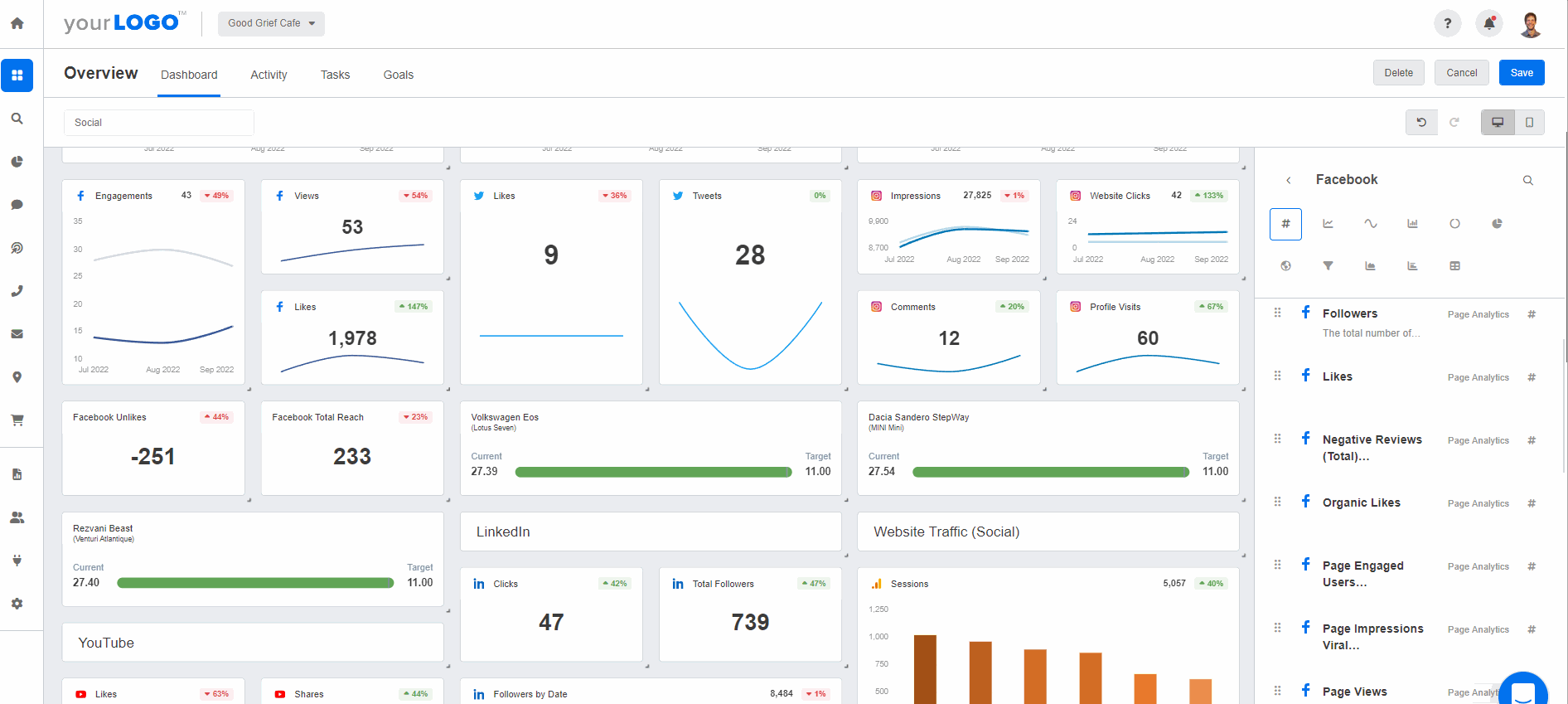
Source: AgencyAnalytics
Pulling data manually from different platforms to create client reports can take hours. You jump between Google Analytics, Facebook Ads Manager and email platforms to compile basic campaign performance data for your presentations.
AgencyAnalytics puts your marketing data in one place for quicker reporting with less manual input.
Key AgencyAnalytics features for marketing agencies
Here are the specific features that help agencies streamline reporting workflows:
Customizable dashboards. See SEO rankings, PPC spend, social engagement and email performance in one view.
Automated client reports. Schedule weekly or monthly reports so clients get updates automatically.
White-label reporting. Reports show your agency branding instead of AgencyAnalytics’ for a professional look.
Campaign comparison functionality. Compare performance across different clients or periods to determine which strategies work best.
These features help marketing teams save time on reporting tasks. With this in mind, the best analytics tools depend on your client reporting needs and data sources.
How to know if AgencyAnalytics is right for your marketing agency
Consider your current reporting workload and client expectations to see if you need to add AgencyAnalytics to your tool suite.
AgencyAnalytics is a good fit if… | Look elsewhere if… |
|---|---|
You manage campaigns across multiple platforms and create client reports manually. | You only need basic reporting from one or two platforms. |
Your clients expect professional, branded reports with consistent delivery schedules. | You prefer simple Excel spreadsheet reports or your clients don’t need detailed analytics. |
You’re a small to midsize agency (five to 20+ clients) that needs to scale reporting without hiring more staff. | You’re a very small agency managing fewer than five clients with simple campaign tracking. |
AgencyAnalytics offers a 14-day free trial, so you can test whether it streamlines your reporting workflows effectively.
AgencyAnalytics integrations
AgencyAnalytics connects with the other marketing tools agencies use daily, including:
Google Analytics 4. Pull website traffic and conversion data directly into client reports.
Mailchimp. Track email marketing performance alongside other campaign metrics.
All standard social media apps. Report performance on Facebook, LinkedIn, Instagram and more.
With over 80 integrations, AgencyAnalytics gives you a comprehensive picture of your marketing efforts to share with clients.
AgencyAnalytics pricing
AgencyAnalytics’ Agency pricing is $179 per month, billed annually. The plan includes 10 clients, with each additional client costing $10 per month.
3. Best for social media management: Hootsuite
Hootsuite is a social media management platform that helps marketing agencies schedule posts, monitor mentions and track performance.
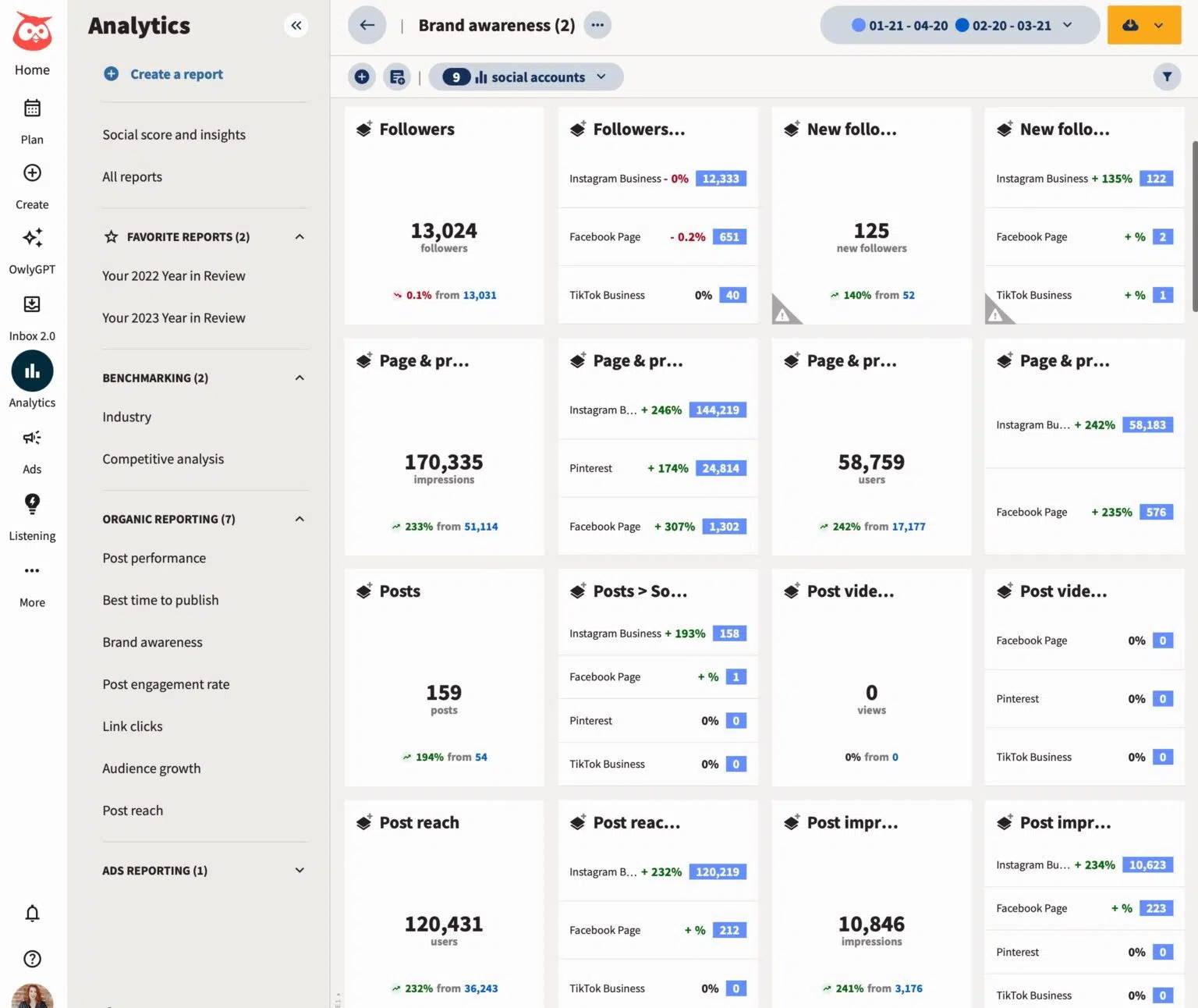
Source: Hootsuite
Managing social media for several clients means constantly switching between apps. Bring different posting schedules and brand voices into the mix, and it gets chaotic fast.
Hootsuite provides a single dashboard to centralize client accounts.
Key Hootsuite features for marketing agencies
Here’s how Hootsuite helps agencies manage multiple social media accounts:
Multi-account posting. Schedule posts across Facebook, Instagram, Twitter and LinkedIn. No need to log in to each platform separately.
Content marketing calendar view. See all planned client posts and spot gaps or overlaps in content schedules.
Social listening. Monitor brand mentions and hashtags for all clients, so you can respond to comments or catch potential issues.
Team collaboration. Assign posts for approval, leave comments on content and manage who can access which client accounts.
As you consider how these features can help your marketing agency organize its social media strategies, remember that the tool depends on your team’s size and account volume.
How to know if Hootsuite is right for your marketing agency
Consider how many social accounts you manage and what your workflow needs are before opting for Hootsuite.
Hootsuite is a good fit if… | Look elsewhere if… |
You manage social media for five or more clients with regular posting schedules. | You only handle social media occasionally or for one or two clients. |
Your team members need collaboration tools for content creation and approval. | You need advanced social commerce features to track return on investment (ROI). |
You want to monitor client mentions and engagement from one place. | You prefer simpler tools focused on just scheduling. |
Hootsuite offers a 30-day free trial so you can see if its functionality matches your needs before you commit.
Hootsuite integrations
Hootsuite connects with popular platforms, including:
Asana. Link social media campaigns to your project management tool.
Slack. Get notifications when posts get published or need approval.
Adobe Creative Suite. Import graphics and videos directly into your content calendar.
Google Analytics 4. Track how social media traffic converts on client websites.
With over 100 integrations available, Hootsuite can likely slot easily into your existing marketing strategies and tools.
Hootsuite pricing
Hootsuite pricing starts at $99 monthly for the Standard tier (billed annually). The plan includes up to five social accounts.
For unlimited social accounts, choose the Advanced plan at $249 per month (billed annually).
4. Best for marketing collaboration and project management: Asana
Asana is a project management platform that helps marketing agencies organize internal workflows and coordinate team tasks.
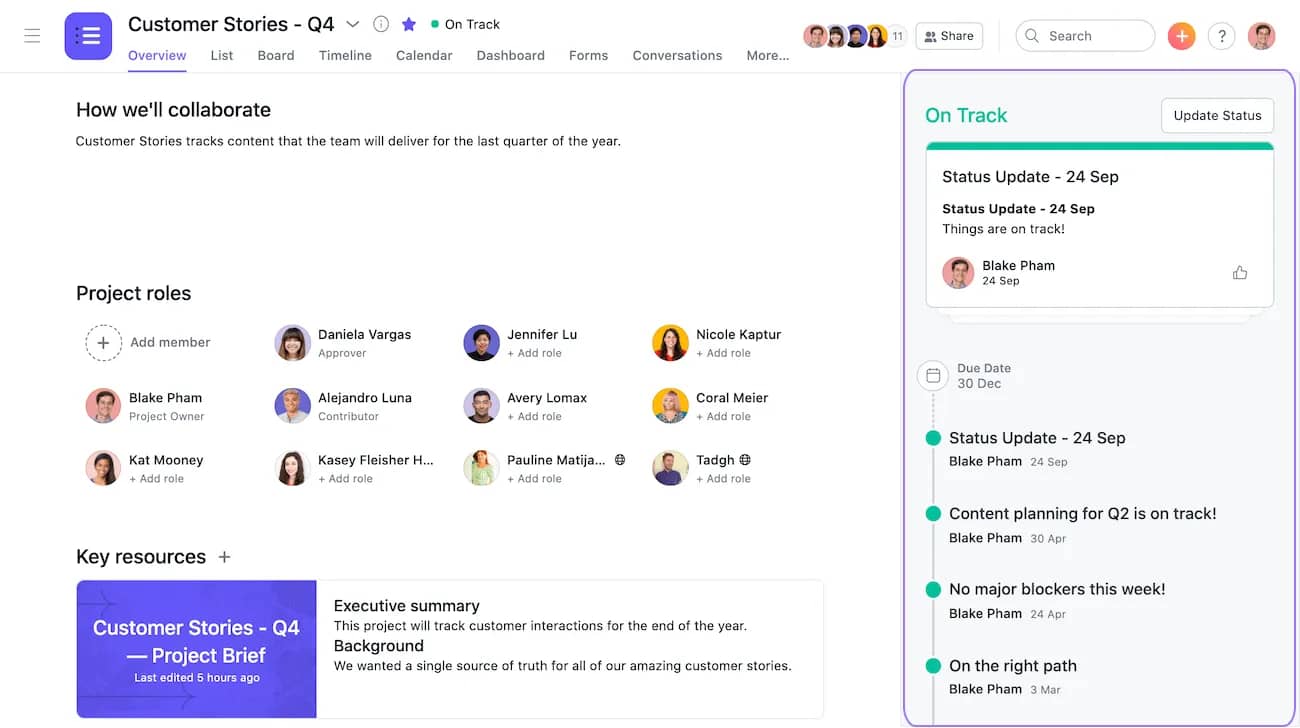
Source: Asana
Marketing campaigns can involve many team members and freelancers. Designers create assets, copywriters draft content and account managers review deliverables.
In addition, everyone has different deadlines. Clear project organization is essential to avoid creative work bottlenecks and campaign launch delays.
Marketing agencies can use Asana to break down campaigns into manageable tasks and keep internal teams coordinated.
Key Asana features for marketing agencies
Here’s how Asana helps marketing agencies keep campaigns on track:
Creative workflow management. Set up approval processes so nothing goes live without proper sign-offs.
Campaign task templates. Create reusable workflows for common projects like product launches or seasonal campaigns.
Resource allocation. See who’s working on what and when, helping you balance workloads and avoid overloading team members.
Internal team communication. Keep project discussions, file sharing and updates organized by campaign.
Good task management can remove a huge headache for agencies. Along with functionality, there are a few other things to consider to see if Asana is right for you.
How to know if Asana is the right marketing agency management software
Consider your current project organization and team collaboration needs:
Asana is a good fit if… | Look elsewhere if… |
You manage campaigns with multiple team members and overlapping deadlines. | You’re a small agency with simple task lists. |
Your team struggles with creative approval processes and project handoffs. | You need advanced time tracking or detailed resource management features. |
You want to standardize workflows across different campaign types. | You prefer simpler tools focused just on basic task management. |
Asana offers a free plan, so you can try the platform out and scale up if necessary.
Asana integrations
There are over 100 Asana integrations, including agency tools like:
Pipedrive. Automatically create a task or project when you start, close or move a deal. It’s ideal if you already use Pipedrive’s CRM and want to use it as your central marketing hub.
Mailchimp. Track Mailchimp email campaigns and key performance indicators (KPIs) in Asana tasks.
Slack. Turn ideas and action items from Slack into trackable tasks and comments.
With plenty of other options, you can sync your marketing agency project management software with your most-used tools.
Asana pricing
Asana’s free plan covers basic task management.
Most agencies will need to start with the Starter plan at $10.99 per month (billed annually). This tier includes features like project dashboards and universal reporting.
Note: If you choose Pipedrive as your marketing CRM, you can add Projects for just $6.67. It’s an ideal option for teams that work best with fewer platforms but still want the functionality of a project management tool.
You get an overview of all your tasks, draw data straight from your CRM and keep your team members and projects on track.
5. Best for search engine-optimized content creation: Surfer SEO
Surfer SEO is a content optimization tool that gives you data-driven guidance to create copy that can rank on search engine results pages (SERPs).
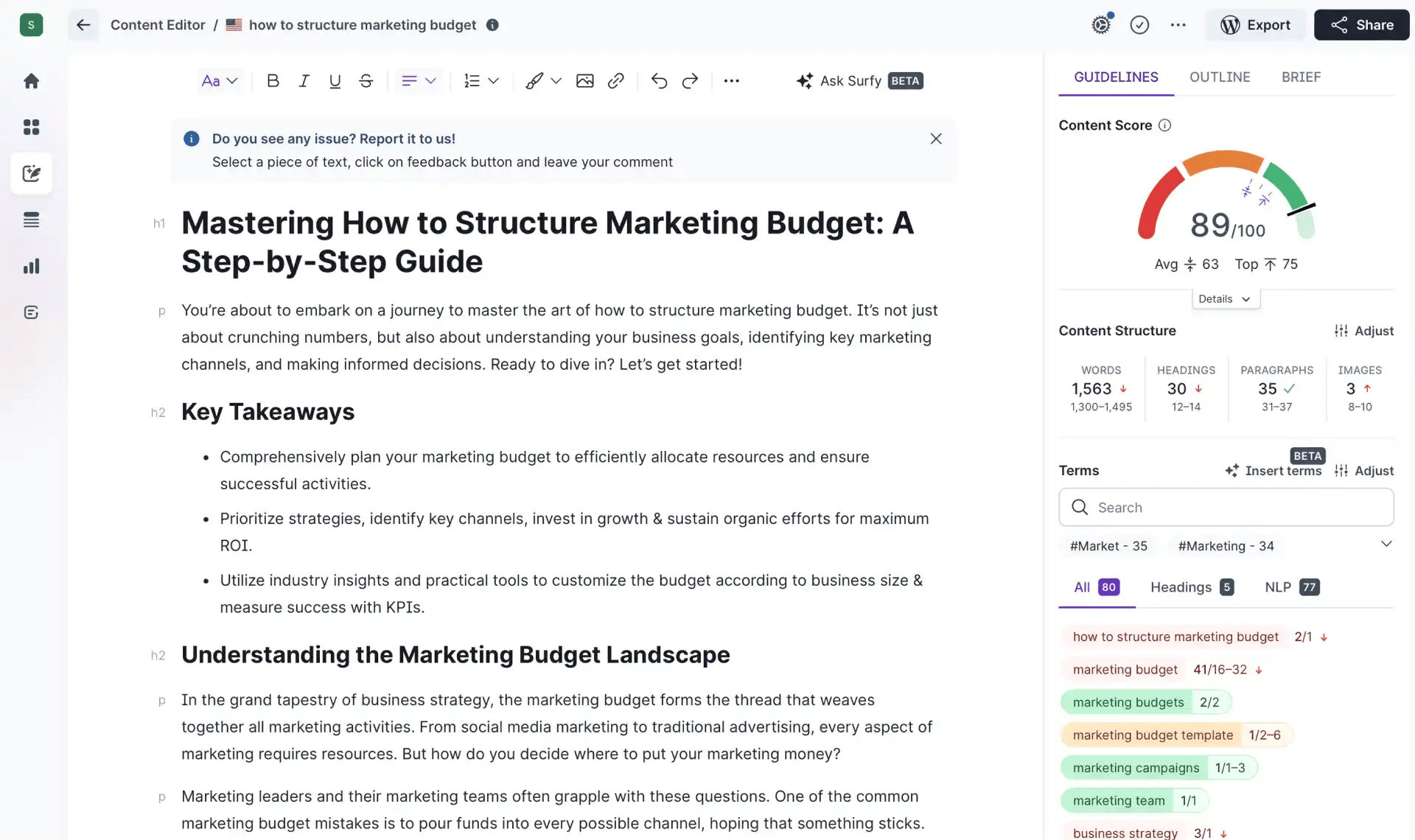
Source: SurferSEO
Content that drives more traffic and generates SEO leads means understanding two things. First, what Google wants to see. Second, what competitors are doing better.
Surfer SEO analyzes the top-ranking pages for any keyword and tells you what your content needs to compete.
With this knowledge, you can deliver measurable traffic increases that justify your clients’ content marketing investment.
Key Surfer SEO features for marketing agencies
These Surfer SEO features help you create content that’s more likely to rank:
Content scoring. Get a real-time score as you write. See how well your content messaging matches what’s currently ranking for your target keywords.
One-click optimization. Use AI to improve content and add internal links.
Content structure guidance. Get recommendations for ideal word count, heading structure and how many times to use key phrases.
Automated SEO audits. Easily find opportunities to improve your client’s traffic.
These features help you create content faster and drive traffic. However, the best SEO tool will depend on how much content you produce and your clients’ goals.
How to know if Surfer SEO is right for your marketing agency
Content marketing is a core part of most agency services, but not every agency needs a content optimization tool. Here’s how to understand if Surfer SEO is for you:
Surfer SEO is a good fit if… | Look elsewhere if… |
You regularly create blog posts for clients across multiple industries. | You only create long-form content occasionally or focus mainly on social media content. |
You need to show measurable SEO improvements and ranking results. | You need a full SEO suite with backlink analysis (which sites link to your content) and technical audits (checking for site issues that impact SEO). |
Your team wants data-driven guidance rather than guessing what will rank well on search engines. | You prefer simpler writing tools without SEO complexity or real-time optimization features. |
Surfer offers a seven-day money-back guarantee for first-time subscribers so you can see if its content workflow fits your team.
Surfer SEO integrations
Surfer SEO connects with standard content creation tools, including:
Google Docs. Optimize content directly in Google Docs with real-time SEO suggestions.
Google Search Console. Analyze your existing content performance and find optimization opportunities.
Contentful. Create content within your content management system (CMS) to reduce copy-and-pasting between tools.
ChatGPT. Get search data while creating AI-generated content.
Surfer SEO also has an API that lets different apps share data.
You can use the API to connect Surfer SEO to your existing tools. Or can use it to build your own content marketing automations.
Surfer SEO pricing
Surfer SEO’s Essential plan is $79 per month (billed annually) and suits small businesses.
At $175 per month (billed annually), the Scale plan includes weekly content performance reports – which may be a better fit for most agencies.
6. Best for multi-client email marketing: Mailchimp
Mailchimp helps you manage email campaigns for multiple clients when you join its Mailchimp & Co program, designed for agencies and freelancers.
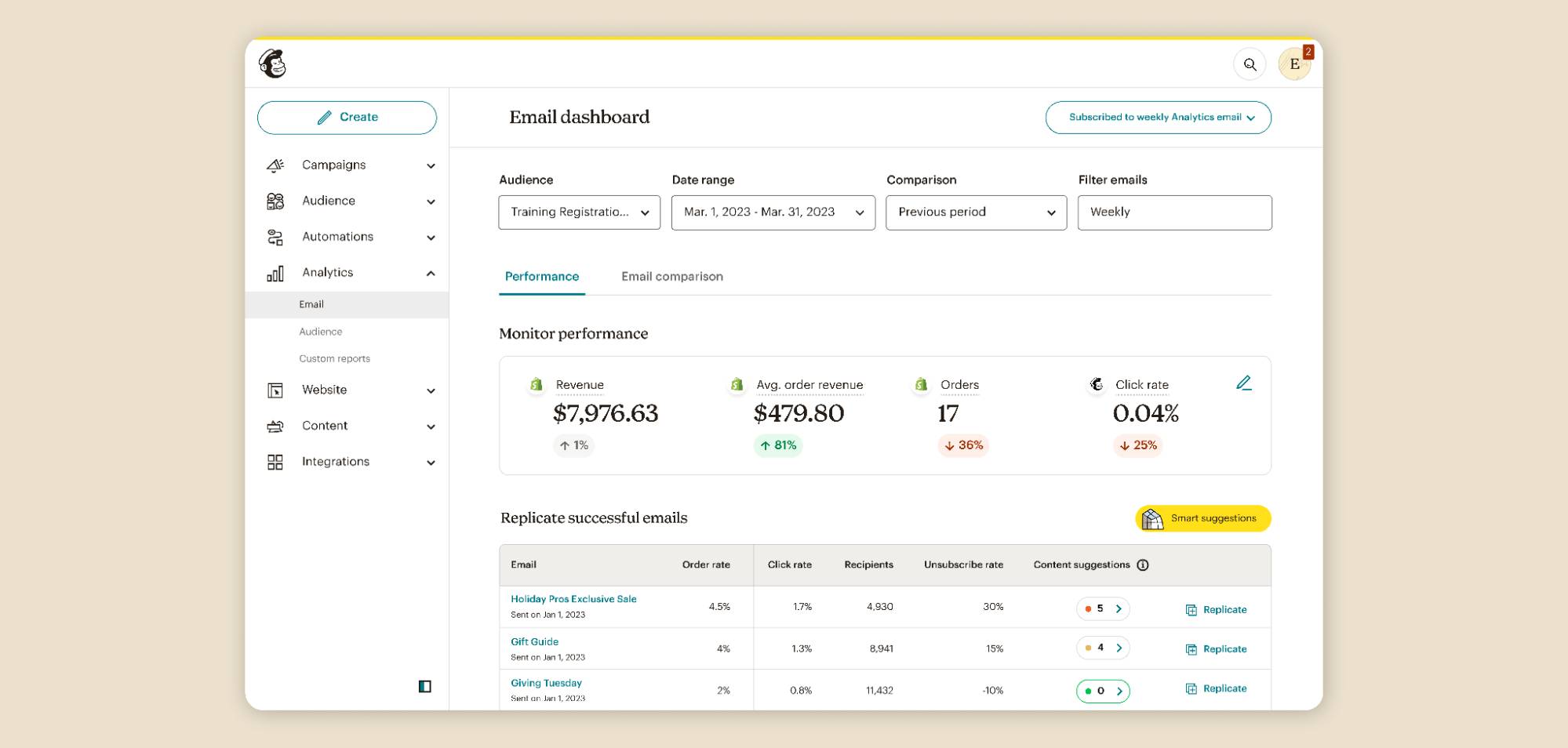
Source: G2
Managing email marketing for multiple clients usually means creating separate accounts for each one. Or mixing client data in often confusing ways.
Mailchimp & Co lets you connect all your client accounts to yours and manage them from one centralized dashboard.
You can switch between client campaigns without losing track of which audience or template belongs to whom.
Key Mailchimp features for marketing agencies
Here are the features that help agencies manage email marketing efficiently:
Drag-and-drop email builder. Create professional email marketing campaigns without needing design skills or coding knowledge.
Landing pages. Capture leads and track conversions from email to sale with Mailchimp’s landing page functionality.
Automated email sequences. Set up welcome sequences, abandoned cart emails and follow-up campaigns based on customer behavior.
Partner directory listing. Get listed in Mailchimp’s Experts Directory to attract new clients seeking email marketing help.
Switching email platforms later can be a pain and even mess with your email deliverability. It’s well worth comparing platforms and features before you make a decision.
How to know if Mailchimp is right for your marketing agency
Here are a few things to consider before choosing Mailchimp as your multi-client emailing platform:
Mailchimp is a good fit if… | Look elsewhere if… |
You manage email marketing for many clients and need centralized account management. | You run simple newsletters for a small amount of clients. |
You want to create landing pages to go with your email campaigns. | You want an email platform that will stay affordable as you scale. |
You’re interested in getting listed in a partner directory to attract new clients. | You prefer working with an email platform that has a simple user interface minus unnecessarily complex functionality. |
Mailchimp’s 14-day free trial lets you see if it’s the email marketing platform for you.
Mailchimp integrations
Mailchimp connects with hundreds of marketing and business apps, including:
Google Analytics. See which email campaigns drive the most traffic and customer conversions on client websites.
Pipedrive. Automatically add new clients to the right email list – ideal if you already use Pipedrive and want to streamline or scale follow-ups with minimal effort. Here’s how to integrate Mailchimp into Pipedrive’s all-in-one marketing automation toolkit.
Shopify. Track purchase behavior and send targeted product recommendation emails for your e-commerce clients.
These connections eliminate manual data entry between your email marketing and other agency tools.
Mailchimp pricing
Mailchimp’s Essentials plan allows you to send up to 10,000 emails per month with three audience segments. The plan costs $13 monthly if you have up to 500 contacts. Annual pricing is available through the sales team.
You join the Mailchimp & Co program when you sign up at no additional cost, or later when you have more email clients.
Tip: Pipedrive has its own email tool, Campaigns by Pipedrive, offering a solid alternative if you want your CRM and email marketing in one place.
The add-on enables you to tailor your marketing messages using your CRM data. The result is more relevant emails and even better conversions.
7. Best for billing and finance operations: Sage Intacct
Sage Intacct is a cloud-based accounting platform that helps marketing agencies manage their invoicing, expense tracking and financial reporting tasks.
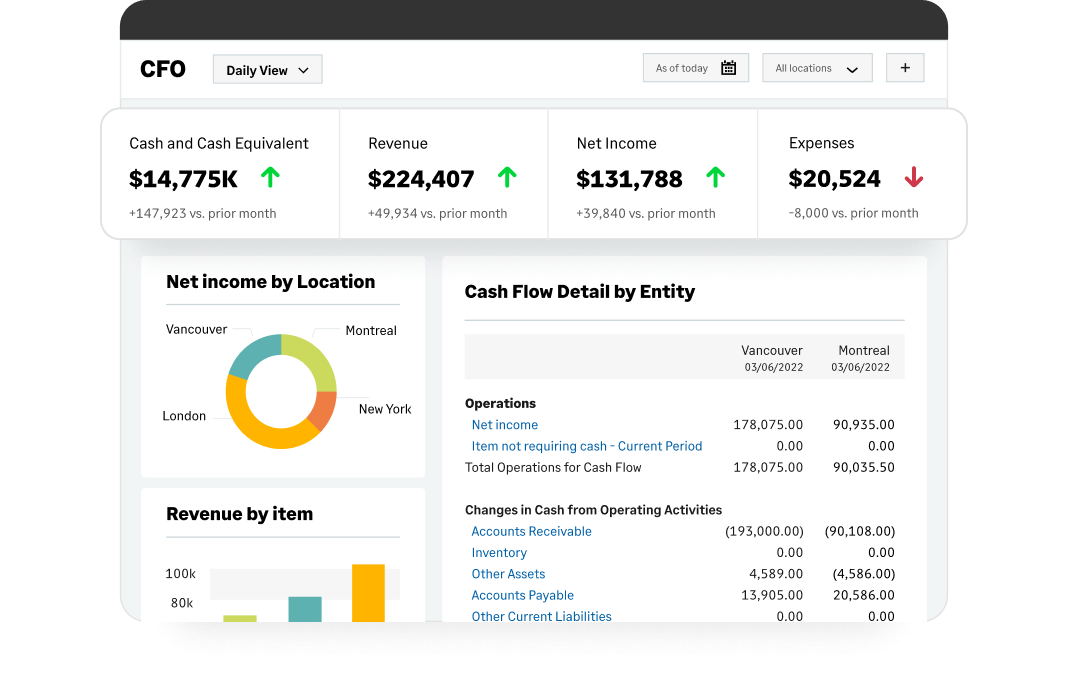
Source: G2
Marketing agencies have complex billing needs. Some clients are on retainer, while others pay per project.
You need to track profitability by campaign or service type. Plus, good forecasting to plan freelancer budgets.
Sage Intacct is for businesses with complex billing that need financial visibility to make informed business decisions.
Key Sage Intacct features for marketing agencies
Sage Intacct offers some features designed to simplify complex agency finances:
Project-based billing. Track billable time and expenses, then automatically generate invoices.
Multi-client financial reporting. See profitability by client, service type or time period to understand which parts of your business make the most money.
Automated invoicing workflows. Set up recurring invoices for retainer clients and automated payment reminders to improve cash flow.
Expense management. Track client expenses, team travel and overhead costs with approval workflows to keep spending organized.
Sage Intacct’s features cater specifically to agencies and project-based businesses looking to keep track of their financial management. You’ll need additional tools to manage different aspects of your marketing services.
How to know if Sage Intacct is right for your marketing agency
Consider your current billing challenges and financial reporting requirements to see if Sage Intacct is a fit.
Sage Intacct is a good fit if… | Look elsewhere if… |
You bill multiple clients with different project types and payment schedules. | You’re a small agency with simple monthly retainer billing. |
You need detailed profitability reporting by campaign or service. | You need basic invoicing, not complex project tracking. |
You want automated billing. | You don’t have a big budget for accounting software. |
Choosing the right billing and accounting software is a big decision. Before you commit, talk to Sage’s sales team to get your questions answered.
Sage Intacct integrations
Sage Intacct comes with hundreds of integrations to make accounting easier, including:
Time tracking apps. Connect tools like Harvest or Toggl to automatically sync billable hours into project billing.
Ramp. Link credit card transactions, reimbursements, payments and vendor bills in real time.
Payroll systems. Unify your payroll and financials without duplicate data entry or complex integrations.
Payment processors. Connect with credit card payment systems to automate invoice collections and improve cash flow.
When your systems work well together, you reduce the chances of billing errors that could become costly over time.
Sage Intacct pricing
Sage Intacct offers custom pricing plans specific to your business. Some sources report annual pricing starting from $9,000.
Final thoughts
There are hundreds of SaaS tools, but the best marketing agency software stack is what makes your life easier. One way to do that is to choose solutions that cover multiple bases.
Pipedrive is an all-in-one agency CRM, project management software and email marketing tool – ideal for handling all your sales and marketing efforts. Try the platform free for 14 days and see how it can transform your workflows.








